Short update on the Purple Line light rail program in Suburban Maryland
Last week, the advocacy group Purple Line Now held a session updating people on what's going on. Present and speaking were the State Secretary of Transportation Pete Rahn, Charles Lattuca, Executive Director for Transit Development and Delivery of the Maryland Transit Administration, for MDOT, the project managers for Montgomery and Prince George's Counties, and a representative from the concessionaire, Purple Line Partners.
-- Purple Line website, Maryland Transit Administration
-- Purple Line Transit Partners website
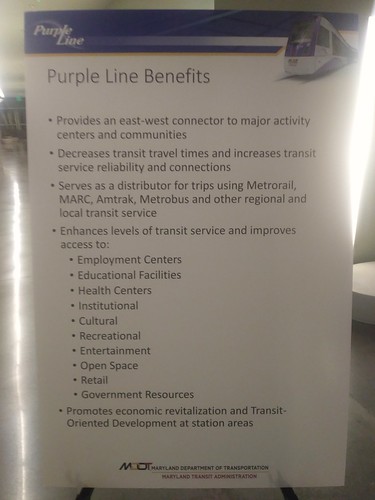 There wasn't a whole lot "new," that was said. Basic utility relocation and tree cutting is underway, the state is still acquiring affected properties, but has acquired most of the properties they need.
There wasn't a whole lot "new," that was said. Basic utility relocation and tree cutting is underway, the state is still acquiring affected properties, but has acquired most of the properties they need. Project delivery has been delayed by the federal lawsuit which prevented construction activities, but since that lawsuit was dismissed, the project is moving forward. It is expected that it will impact the delivery but not by the full year of delay.
Another lawsuit has been filed ("Purple Line Opponents File New Lawsuit in Controversial Judge's Court," Bethesda Magazine) but Sec. Rahn believes that the materials supporting the "record of decision" are very strong and that the pending lawsuit will not be successful.
There are "Community Advisory Committees" for roughly each two-mile section of the project. The committees mostly deal with mitigation and management of construction and are open to the public.
During the process so far, a couple areas have had design changes as a result of community involvement, but otherwise the design is pretty much set.
People were excited by Montgomery County being picked as a finalist for Amazon's second headquarters, in which the White Flint district was offered, and asked questions about how the Purple Line might impact the likelihood of the County winning the bid.
Sadly, I don't expect much traction on my "Transformational Projects Action Plan" in association with the Purple Line as a transit infrastructure project, which I wrote about in a multi-part series:
-- Setting the stage for the Purple Line light rail line to be an overwhelming success: Part 1 | simultaneously introduce improvements to other elements of the transit network
-- Part 2 | the program (macro changes)
-- Part 3 | influences
-- Part 4 | Making over New Carrollton as a transit-centric urban center and Prince George's County's "New Downtown"
-- PL #5: Creating a Silver Spring "Sustainable Mobility District"
- Part 1: Setting the stage
- Part 2: Program items 1- 9
- Part 3: Program items 10-18
- Map for the Silver Spring Sustainable Mobility District
- (Big Hairy) Projects Action Plan(s) as an element of Comprehensive/Master Plans
- Creating the Silver Spring/Montgomery County Arena and Recreation Center
-- Part 6 | Creating a transportation development authority in Montgomery and Prince George's County to effectuate placemaking, retail development, and housing programs in association with the Purple Line
-- Part 7 | Using the Purple Line to rebrand Montgomery and Prince George's Counties as Design Forward
Initially, the TPAP for a "complementary transit network improvement plan" (Part 2 | the program (macro changes)) for the Purple Line had 19 items, but I added one item, an in-city MARC station on the Penn/Camden Lines and renumbered the list.
Sadly, other than some basics like an integrated map, SmarTrip use, and possibly fare integration (Items #1, #2, #3), none of this is on the table. Here is the original list:
1. Change the WMATA Metrorail map so that it includes the Purple Line and regional railroad services.
2. Integrate the Purple Line light rail line into the Metrorail fare system.
3. Integrate MARC fares into the SmarTrip/ CharmCard fare media system.
4. Introduce bi-directional passenger rail service between DC and Frederick on the MARC Brunswick Line.
-- This could be an element of Montgomery County's proposal to be home to the Amazon HQ2. At the time of writing, I didn't think to suggest extending service to the weekends.
5. Consider charging DC-Montgomery County trips on a bi-directional Brunswick Line using the Metrorail/Purple Line tolling/fare schedule. That would treat mileage from railroad trips in the context of a complete (linked) trip on railroad+subway+light rail as a single fare.
or the related TPAP for Silver Spring as a Sustainable Mobility and Innovation District.
6. The White Flint Sector Plan calls for an infill MARC station. Plans to build that station should be accelerated as part of this proposal.
-- This is all the more "important" given that Montgomery County's White Flint district is being considered for the Amazon HQ2.
Similarly it's an issue in Boston too, concerning redevelopment in the Allston area ("In Allston, the transit lesson we never learn-," Boston Globe). There, Harvard University has recently offered to fund an interim commuter rail station, as well as to pay for half ($50 million) of a completed station.
7. Build an infill train station in DC on the Penn Line, serving the New York Avenue corridor.
8. Provide integrated train arrival information screens at Metrorail, Light Rail, and MARC stations.
9. Provide integrated bus arrival and departure information screens at Metrorail, Light Rail, and MARC stations.
10. Bus service in certain corridors between DC and Maryland should be extended and/or frequency increased to better link these areas to the new light rail service.
11. Montgomery County bus system improvements with the launch of the Purple Line and bi-directional service on the MARC Brunswick Line should include launch of planned Bus Rapid Transit services.
12. Rearticulate, rebrand, and reposition-extend the Prince George's County TheBus bus transit service. Change the name of the service and the graphic design of the bus livery.
13. Consider a redesign and rebranding of the metropolitan area's bus systems into an integrated framework, comparable to that of GoTransit in the Raleigh-Durham area.
14. Set the opening of the Purple Line as the deadline for the integration of the MARC Penn Line and VRE Fredericksburg Line into one combined railroad passenger service.
-- This can't really happen until the Long Bridge connecting DC and Virginia is expanded to four tracks and that won't be happening by 2022, although theoretically, it could were a crash program to be instituted.]
15. Set the opening of the Purple Line as the deadline for the implementation of a full-fledged integrated Night Owl bus network for the DC metropolitan area.
-- WMATA is taking some steps for this. Cycling on Wisconsin Avenue earlier in the week, I noticed that WMATA now has a "late night bus" sign with a "nite owl" logo. I thought I took a photo of the signage, but I can't find it, so I'll have to double back.
16. Create a cheap weekend pass to use the local transit network, especially Metrorail.
17. Incorporate quantum improvements in bicycle facilities across the mobility network in association with the launch of the Purple Line.
-- A few months later I suggested creating a bike mobility hub at National Airport ("Why not a bicycle hub at National Airport?, focused on capturing worker trips but open to all"), this should be included in this program but as a separate item, as well as the proposed complementary transit network improvement plan for Northern Virginia ("Using the Silver Line as the priming event, what would a transit network improvement program look like for NoVA?")
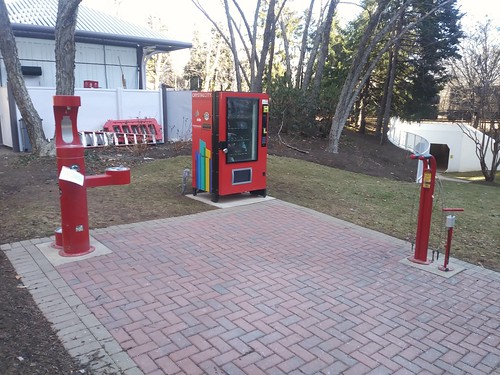
Bicycle hub with vending machine, drinking fountain, repair stand, air pump, Crystal City, Arlington, Virginia
18. Rearticulate transportation demand management programming and services in conjunction with the PL launch, including a single network of "customer information centers."
19. WMATA should upgrade its Metrorail station bus shelters.
20. Create "sustainable mobility" corridors in Silver Spring (and other places), complementing the new PL.
============
Items to Add
============
WRT the Purple Line TPAP, here are some additions.
1. Weekend service on the MARC Brunswick line.
2. A bicycle mobility hub, bicycle sharing stations, better bike parking, and accommodations for Car2Go at National Airport.
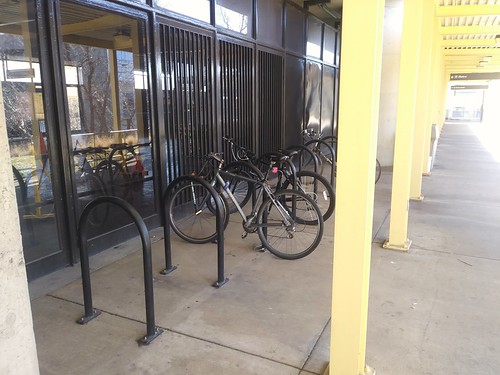
The main bike parking offered at National Airport is next to the Metrorail station.

Plenty of space under the elevated subway tracks at National Airport
3. Completing the Metropolitan Branch Trail in DC, the north-south shared use path between Silver Spring and DC.

Rendering, Metropolitan Branch Trail cycletrack on Blair Road NW
This complements improvements to the Georgetown Branch Trail and the Capital Crescent Trail which will be made as part of the construction of the Purple Line. It needs to be paired with a cycletrack on Fenton Avenue, which is item #3 in "PL #5: Creating a Silver Spring "Sustainable Mobility District" | Part 2: Program items 1 - 9."
The remaining MBT segments to be constructed are in DC. DDOT is moving forward with a section of the trail to be constructed on Blair Road, by removing one northbound traffic lane, and a portion between the Maryland border and Piney Branch Road. Another segment is being developed as an interim route, between Fort Totten Metrorail Station and Blair Road.
Previously the National Park Service did not favor using park lands for the trail, but they have since reconsidered, and DDOT plans to move forward on creating an alternative routing off-road in the section between Fort Totten and Blair Road.
At this point, funding for planning the last segment, between Aspen Street and Piney Branch Road, also serving the Takoma Metrorail Station, has not been appropriated.
Ideally, in combination with a top notch cycletrack on Fenton Street, DC should commit to "finishing" its sections of the Metropolitan Branch Trail by the opening of the Purple Line.
4. An expanded program of urban design improvements and embellishments in station catchment areas ("station sheds") for each Purple Line station. This is Silver Spring item #8 ("PL #5: Creating a Silver Spring "Sustainable Mobility District" | Part 2: Program items 1 - 9"), but should be a standalone item in the master program. There is already public art slated for each station, but not much beyond that.
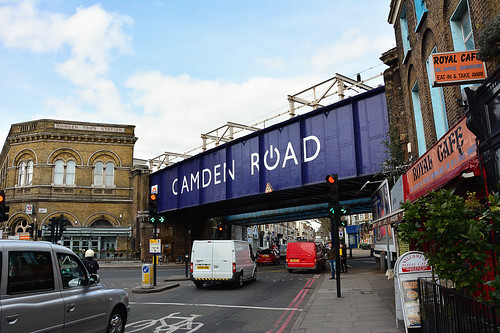
Neighborhood identification painted on a bridge overpass in London.
In keeping with ideas expressed in past blog entries concerning the Takoma Langley Crossroads Transit Center and the Rhode Island Metrorail Station, one idea would be to provide art lighting of the light rail bridge over Connecticut Avenue.

Rendering, light rail bridge over Connecticut Avenue.

Tempe Arizona light rail bridge
For longer term planning, rather than an intermediate term transit network improvement program:
5. Begin preliminary planning for extending the Purple Line from New Carrollton to Alexandria.
This would complete much of the originally conceptualized Purple Line routing in Maryland, specifically in Prince George's County, and would provide a way to bring better transit connectivity to the National Harbor district in Southern PG County.
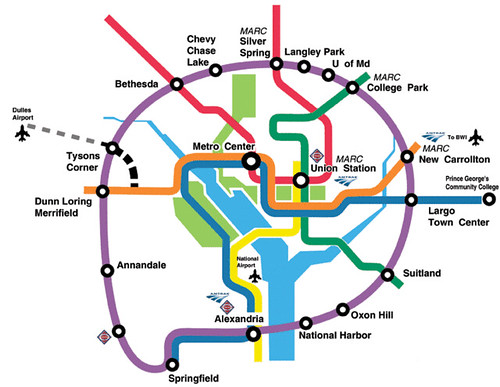
Sierra Club concept map of a complete Purple Line.
6. Integrated corridor management planning in the I-270-Rockville Pike-Wisconsin Avenue-Connecticut Avenue-Beach Drive corridor ("Transportation network interruptions as an opportunity" and "Transportation network service interruptions part 3: corridor/commute shed management for Northwest DC and Montgomery County, Maryland"), especially given the Amazon HQ2 initiative and Maryland's Governor Hogan's program for HOT lanes on I-270 and I-495 ("Maryland HOT lanes extension proposal by Governor Hogan").
Labels: bicycle and pedestrian planning, change-innovation-transformation, fixed rail transit service, public realm framework, transit, transit marketing, transportation planning, urban design/placemaking




0 Comments:
Post a Comment
<< Home